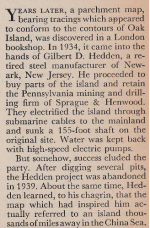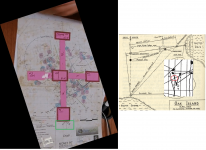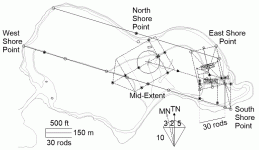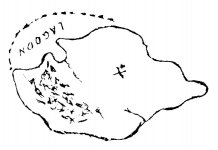freeman
Sr. Member
- Apr 5, 2003
- 361
- 700
Actually just give Marty & Rick a phone call and ask them how long they have known about it and where they got their copy from.
Follow along with the video below to see how to install our site as a web app on your home screen.
Note: This feature may not be available in some browsers.
It’s my understanding that there is not 1 pirate treasure map that exists anywhere, ever. The concept of a pirate treasure map is a creation from literature. If we all do our homework, we will eventually all be in agreeement that pirate treasure maps simply don’t exist.
Thanks, I get the message, The theory has supporters and detractors. If the supporters owned the island then they’d doubtless test the hypothesis. Detractors wouldn’t bother because, knowing the answer in advance, they’ve decided it would be a waste of time.
Well, you can’t expect to be able to test every hypothesis. You have to be selective, and the unfailing ability to predict the results of a test inspection and dig, the way some of you can, is a rare skill! You could have saved Rick and Marty a whole load of money!
Have you shared your solution with Rick and Marty, in order to save them money?
If not.....why not ?
It seems you're referring to the article in Collier’s (Sept. 29, 1906) by Josephine Fredea under the title, “The Lure of the Pirate’s Gold.” A guy buys an old manor house, finds an old chest that belonged to a former pirate or privateer etc...According to my contact, the file contained papers pertaining to privateering late in the first half of the 18th century and contained several maps, though they didn’t know the identity of the island. It appears that Juan Fernandez was the first choice, but he recalled that his father had been visited by someone from Halifax (which he'd assumed at the time was Halifax in the UK.) After the visit, his father had playfully asked my contact if he’d like to go on a treasure hunt.


Yes, I contacted them soon after they acquired their share of the island and again in 2012 when COOI was being mooted, then again a couple of years back - when I sent them copies of my books and a link to my web site, and I also contacted Prometheus. Of course, you never get in touch with Rick and Marty themselves - I've always dealt with one of the team.
I first came up with the idea in the 1970s and wrote to the island in 1984, but first provided details to Triton Alliance in 1986. I spoke to David Tobias at that time and sent him a summary, but they weren't interested. I wrote to Dan Blankenship a few times but I understand he was in the habit of binning such approaches. I wrote to Fred Nolan perhaps a dozen times trying to explain why it was important to me to talk to him about his surveys. He never replied, and I know I had the correct address.
I'm not sure that investigating the hypothesis now would be easy, because so much has been destroyed. I'd need an original ground marker in its correct position to start off with. I almost begged Triton to be able to attempt to relocate the Mallon Triangle, survey it, document if fully and hand the results to them. They weren't interested. I learnt a few years back that the triangle had been relocated but was in a really poor state and might disappear if not protected. However, nobody has ever considered these markers to be important enough to protect.
Above all, having watched COOI, it seems that those who present proposals don't get a second chance if treasure is not immediately recovered. You'll appreciate that there's far more to the geometry than I've shown and there are alternative scenarios. Sadly, only Rick and Marty have the luxury of testing alternative scenarios. Everyone else must choose correctly first time! Laverne Johnson famously fell foul of this situation with Triton - he was never given a second chance.
So, I no longer hold out any hope. Mine is just one of many such rejected cases, and declining health prevents me now from participating in any investigation, but I reckon I tried!
Which part of this are you having trouble coming to terms with they are using this on Oak Island and it's no secret?
The problem I have with complex geometric solutions to lost treasure type problems is that there a usually a number of variations to any result of striking lines between multiple points of "possible" reference. In fact, that if just one of those points should go missing, or be altered by nature or man, is also problematic IMO.

I agree with you that the map was mostly likely from the late 17th century to the early 18th century...
Do you have any idea as to the origin of the map (English, Dutch, Spanish, etc.)?

